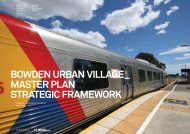MAPPING CULTURE
Mapping-Culture-Venues-and-Infrastructure-in-the-City-of-Sydney
Mapping-Culture-Venues-and-Infrastructure-in-the-City-of-Sydney
Create successful ePaper yourself
Turn your PDF publications into a flip-book with our unique Google optimized e-Paper software.
To address the breadth question, the UNESCO’s Framework for Cultural Statistics<br />
(2009) classified culture into different cultural domains that represent a common set<br />
of economic and social activities that have been regarded typically as ‘cultural’. The six<br />
domains included in UNESCO’s 2009 framework are:<br />
●<br />
●<br />
●<br />
●<br />
●<br />
●<br />
Cultural and natural heritage: museum, archaeological and historical places,<br />
cultural landscapes, natural heritage<br />
Performance and celebration: performing arts, music, festivals, fairs and feasts<br />
Visual arts and crafts: fine arts, crafts, photography<br />
Books and print media: books, newspapers and magazines, other printed<br />
matters, virtual publishing, libraries, book fairs<br />
Audiovisual and media: film and video, television and radio, internet TV and<br />
podcasting, video games<br />
Design and creative services: fashion design, graphic design, interior design,<br />
landscape design, architectural services, advertising services.<br />
There are also two ‘related domains’ which consist of the activities that may have a<br />
cultural character, but their main component is not regarded as principally cultural:<br />
●<br />
●<br />
Tourism: travel and tourist services, hospitality and accommodation<br />
Sport and recreation: sport, physical fitness and well-being, amusement and<br />
theme parks, gambling.<br />
In addition, there are transversal domains that can be applied to all cultural and<br />
related domains. Whilst the elements in the transversal domains are of importance to<br />
cultural activities, for UNESCO they may be considered as only ‘partially cultural’.<br />
These transversal domains are:<br />
● Intangible cultural heritage: oral traditions and expressions, rituals, languages<br />
social practices,<br />
● Education and training: learning activities that support culture, dance schools,<br />
literary criticism<br />
● Archives and preservation: collection and repository of cultural forms,<br />
preservation of historic sites and buildings, sound archives, picture libraries<br />
● Equipment and supporting materials: supporting industries and ancillary<br />
services that can be used as ‘tools’ for cultural products and activities, such as<br />
IT, computer, internet.<br />
27



